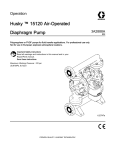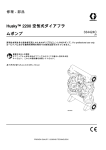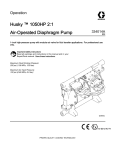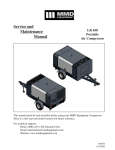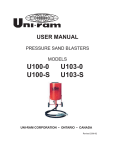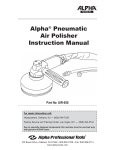Download Graco 3A2578B User's Manual
Transcript
Operation Husky™ 2200 Air-Operated Diaphragm Pump 3A2578B EN Polypropylene and PVDF pumps for fluid transfer applications, including high viscosity materials. For professional use only. Not for use in European explosive atmosphere locations. Important Safety Instructions Read all warnings and instructions in this manual and in your Repair/Parts manual. Save these instructions. Maximum Working Pressure: 125 psi (0.86 MPa, 8.6 bar) PROVEN QUALITY. LEADING TECHNOLOGY. Contents Warnings ........................................................... 3 Ordering Information ........................................... 6 Related Manuals ................................................ 6 Configuration Number Matrix ............................... 7 Installation.......................................................... 8 General Information ..................................... 8 Tighten Fasteners ........................................ 8 Tips to Reduce Cavitation............................. 8 Mount The Pump ......................................... 8 Ground The System ..................................... 10 Air Lines ...................................................... 10 Air Exhaust Ventilation ................................. 11 Fluid Supply Line ......................................... 12 Fluid Outlet Line........................................... 12 Flange Connections ..................................... 13 Operation ........................................................... 14 Pressure Relief Procedure............................ 14 2 Tighten Fasteners ........................................ 14 Flush the Pump Before First Use .................. 14 Start and Adjust the Pump ............................ 14 Pump Shutdown .......................................... 14 Maintenance ...................................................... 15 Maintenance Schedule ................................. 15 Lubrication................................................... 15 Tighten Threaded Connections ..................... 15 Flushing and Storage ................................... 15 Torque Instructions ............................................. 16 Notes................................................................. 17 Dimensions ........................................................ 18 Performance Charts............................................ 20 Technical Data ................................................... 22 Graco Standard Husky Pump Warranty................ 24 3A2578B Warnings Warnings The following warnings are for the setup, use, grounding, maintenance, and repair of this equipment. The exclamation point symbol alerts you to a general warning and the hazard symbols refer to procedure-specific risks. When these symbols appear in the body of this manual or on warning labels, refer back to these Warnings. Product-specific hazard symbols and warnings not covered in this section may appear throughout the body of this manual where applicable. WARNING FIRE AND EXPLOSION HAZARD Flammable fumes, such as solvent and paint fumes, in work area can ignite or explode. To help prevent fire and explosion: • Use equipment only in well ventilated area. • Eliminate all ignition sources; such as pilot lights, cigarettes, portable electric lamps, and plastic drop cloths (potential static arc). • Keep work area free of debris, including solvent, rags and gasoline. • Do not plug or unplug power cords, or turn power or light switches on or off when flammable fumes are present. • Ground all equipment in the work area. See Grounding instructions. • Use only grounded hoses. • Hold gun firmly to side of grounded pail when triggering into pail. Do not use pail liners unless they are antistatic or conductive. • Stop operation immediately if static sparking occurs or you feel a shock. Do not use equipment until you identify and correct the problem. • Keep a working fire extinguisher in the work area. • Route exhaust away from all ignition sources. If diaphragm ruptures, fluid may be exhausted with air. Static charge may build up on plastic parts during cleaning and could discharge and ignite flammable vapors. To help prevent fire and explosion: • Clean plastic parts only in well ventilated area. • Do not clean with a dry cloth. • Do not operate electrostatic guns in equipment work area. PRESSURIZED EQUIPMENT HAZARD Fluid from the equipment, leaks, or ruptured components can splash in the eyes or on skin and cause serious injury. • Follow the Pressure Relief Procedure when you stop spraying/dispensing and before cleaning, checking, or servicing equipment. • Tighten all fluid connections before operating the equipment. • Check hoses, tubes, and couplings daily. Replace worn or damaged parts immediately. 3A2578B 3 Warnings WARNING EQUIPMENT MISUSE HAZARD Misuse can cause death or serious injury. • Do not operate the unit when fatigued or under the influence of drugs or alcohol. • Do not exceed the maximum working pressure or temperature rating of the lowest rated system component. See Technical Data in all equipment manuals. • Use fluids and solvents that are compatible with equipment wetted parts. See Technical Data in all equipment manuals. Read fluid and solvent manufacturer’s warnings. For complete information about your material, request MSDS from distributor or retailer. • Do not leave the work area while equipment is energized or under pressure. • Turn off all equipment and follow the Pressure Relief Procedure when equipment is not in use. • Check equipment daily. Repair or replace worn or damaged parts immediately with genuine manufacturer’s replacement parts only. • Do not alter or modify equipment. Alterations or modifications may void agency approvals and create safety hazards. • Make sure all equipment is rated and approved for the environment in which you are using it. • Use equipment only for its intended purpose. Call your distributor for information. • Route hoses and cables away from traffic areas, sharp edges, moving parts, and hot surfaces. • Do not kink or over bend hoses or use hoses to pull equipment. • Keep children and animals away from work area. • Comply with all applicable safety regulations. THERMAL EXPANSION HAZARD Fluids subjected to heat in confined spaces, including hoses, can create a rapid rise in pressure due to the thermal expansion. Over-pressurization can result in equipment rupture and serious injury. • Open a valve to relieve the fluid expansion during heating. • Replace hoses proactively at regular intervals based on your operating conditions. PLASTIC PARTS CLEANING SOLVENT HAZARD Many solvents can degrade plastic parts and cause them to fail, which could cause serious injury or property damage. • Use only compatible water-based solvents to clean plastic structural or pressure-containing parts. • See Technical Data in this and all other equipment instruction manuals. Read fluid and solvent manufacturer’s MSDSs and recommendations. 4 3A2578B Warnings WARNING TOXIC FLUID OR FUMES HAZARD Toxic fluids or fumes can cause serious injury or death if splashed in the eyes or on skin, inhaled, or swallowed. • Read MSDSs to know the specific hazards of the fluids you are using. • Route exhaust away from work area. If diaphragm ruptures, fluid may be exhausted into the air. • Store hazardous fluid in approved containers, and dispose of it according to applicable guidelines. BURN HAZARD Equipment surfaces and fluid that’s heated can become very hot during operation. To avoid severe burns: • Do not touch hot fluid or equipment. PERSONAL PROTECTIVE EQUIPMENT Wear appropriate protective equipment when in the work area to help prevent serious injury, including eye injury, hearing loss, inhalation of toxic fumes, and burns. This protective equipment includes but is not limited to: • Protective eyewear, and hearing protection. • Respirators, protective clothing, and gloves as recommended by the fluid and solvent manufacturer. 3A2578B 5 Ordering Information Ordering Information To Find Your Nearest Distributor Distributor Note 1. Visit www.graco.com. 1. To find part numbers for new pumps or kits, use the Online Husky Selector Tool. 2. Click on Where to Buy and use the Distributor Locator. To Specify the Configuration of a New Pump Please call your distributor. OR Use the Online Husky Selector Tool on the Process Equipment page at www.graco.com. To Order Replacement Parts Please call your distributor. 2. To find part numbers for replacement parts: a. Use the 20–digit number from the ID plate on the pump. If you only have the Graco 6–digit part number, use the selector tool to find the corresponding 20–digit number. b. Use the Configuration Number Matrix on the next page to understand which parts are described by each digit. c. Use the Repair/Parts Manual 3A2714. Refer to the main Parts illustration and to the Parts/Kits Quick Reference. Follow the page references on these two pages for further ordering information, as needed. 3. Please call Graco Customer Service to order. Related Manuals Manual Number Title 3A2714 Husky 2200 Air-Operated Diaphragm Pump, Repair/Parts 6 3A2578B Configuration Number Matrix Configuration Number Matrix Check the identification plate (ID) for the Configuration Number of your pump. Use the following matrix to define the components of your pump. PART NO. CONFIGURATION NO. DATE CODE SERIES MAX WPR PSI-bar SERIAL NO. MADE IN Graco Inc., P.O. Box 1441 Mpls, MN 55440 USA Sample Configuration Number: 2200P 2200P-P01AP1PPPTFKPT P01A P1 Pump Model Center Section and Air Fluid Covers and Valve Manifolds Pump 2200P Center Section and Air Valve Material P01A Polypropylene 2200F P01G Polypropylene PVDF Polypropylene PP PT FK Balls Seats Fluid Covers and Manifolds Standard Diaphragms Overmolded Diaphragms P1 P2 Seat Material Ball Material Diaphragm Material PP PV SP SS FK PT SP FK PO PT SP PVDF Santoprene Stainless Steel 3A2578B FKM PTFE Santoprene PT Manifold and Seat Seals For Use With F2 Polypropylene Diaphragms Polypropylene, Center Flange, ANSI/DIN Polypropylene, End Flange, ANSI/DIN PVDF, End Flange, ANSI/DIN FKM PTFE/EPDM Overmolded Manifold and Seat Seal Material PT PTFE PTFE/Santoprene 2–Piece Santoprene 7 Installation Installation General Information The Typical Installation shown is only a guide for selecting and installing system components. Contact your Graco distributor for assistance in planning a system to suit your needs. Always use Genuine Graco Parts and accessories. Be sure all accessories are adequately sized and pressure rated to meet the system’s requirements. Reference letters in the text, for example (A), refer to the callouts in the figures. Variations in color between the plastic components of this pump are normal. Color variation does not affect the performance of the pump. Tighten Fasteners Before mounting and using the pump for the first time, check and retorque all external fasteners. Follow Torque Instructions, page 16, or see the torque tag on your pump. After the first day of operation, retorque the fasteners. c. Increase the size of the suction piping. NOTE: Be sure the inlet fluid pressure does not exceed 25 % of the outlet working pressure. 3. Reduce liquid velocity: Slow the cyclic rate of the pump. Pumped liquid viscosity is also very important but normally is controlled by factors that are process dependent and cannot be changed to reduce cavitation. Viscous liquids are more difficult to pump and more prone to cavitation. Graco recommends taking all the above factors into account in system design. To maintain pump efficiency, supply only enough air pressure to the pump to achieve the required flow. Graco distributors can supply site specific suggestions to improve pump performance and reduce operating costs. Mount The Pump Tips to Reduce Cavitation Cavitation in an AODD pump is the formation and collapse of bubbles in the pumped liquid. Frequent or excessive cavitation can cause serious damage, including pitting and early wear of fluid chambers, balls, and seats. It may result in reduced efficiency of the pump. Cavitation damage and reduced efficiency both result in increased operating costs. Cavitation depends on the vapor pressure of the pumped liquid, the system suction pressure, and the velocity pressure. It can be reduced by changing any of these factors. 1. Reduce vapor pressure: Decrease the temperature of the pumped liquid. 2. Increase suction pressure: a. Lower the installed position of the pump relative to the liquid level in the supply. b. Reduce the friction length of the suction piping. Remember that fittings add friction length to the piping. Reduce the number of fittings to reduce the friction length. 8 To avoid serious injury or death from toxic fluid or fumes: • Ventilate to a remote area. The pump exhaust air may contain contaminants. See Air Exhaust Ventilation, page 11. • Never move or lift a pump under pressure. If dropped, the fluid section may rupture. Always follow the Pressure Relief Procedure, page 14, before moving or lifting the pump. 1. Be sure the mounting surface can support the weight of the pump, hoses, and accessories, as well as the stress caused during operation. 2. For all mountings, be sure the pump is secured with screws through the mounting feet. 3. Make sure the surface is flat and that the pump doesn’t wobble. 4. For ease of operation and service, mount the pump so air valve, air inlet, fluid inlet and fluid outlet ports are easily accessible. 3A2578B Installation Accessories/Components Not Supplied System Components A Air supply line J Air inlet port (not visible) B Bleed-type master air valve (may be required for your pump) Air filter/regulator assembly K Air exhaust port and muffler L Fluid inlet port M Fluid outlet port N Mounting feet C D E F Master air valve (to isolate the filter/regulator for service) Grounded flexible fluid supply line G Fluid drain valve (may be required for your pump) Fluid shutoff valve H Grounded, flexible fluid outlet line 3A2578B 9 Installation Ground The System The equipment must be grounded to reduce the risk of static sparking. Static sparking can cause fumes to ignite or explode. Grounding provides an escape wire for the electrical current. • Always ground the entire fluid system as described below. • Polypropylene and PVDF pumps are not conductive and are not for use with flammable fluids. • Follow your local fire codes. Before operating the pump, ground the system as explained below. • Pump: Always ground the entire fluid system by making sure the fluid has an electrical path to a true earth ground. • Air and fluid hoses: Use only grounded hoses with a maximum of 500 ft (150 m) combined hose length to ensure grounding continuity. • Air compressor: Follow manufacturer’s recommendations. Air Lines 1. Install an air regulator and gauge (C) to control the fluid pressure. The fluid stall pressure will be the same as the setting of the air regulator. 2. Locate a bleed-type master air valve (B) close to the pump and use it to relieve trapped air. Be sure the valve is easily accessible from the pump and located downstream from the regulator. Trapped air can cause the pump to cycle unexpectedly, which could result in serious injury from splashing. 3. Locate another master air valve (D) upstream from all air line accessories and use it to isolate them during cleaning and repair. 4. An air line filter (C) removes harmful dirt and moisture from the compressed air supply. 5. Install a grounded, flexible air hose (A) between the accessories and the 3/4 npt(f) pump air inlet. • Fluid supply container: Follow local code. • Solvent pails used when flushing: Follow local code. Use only conductive metal pails, placed on a grounded surface. Do not place the pail on a nonconductive surface, such as paper or cardboard, which interrupts grounding continuity. Check your system electrical continuity after the initial installation, and then set up a regular schedule for checking continuity to be sure proper grounding is maintained. 10 3A2578B Installation Air Exhaust Ventilation To provide a remote exhaust: If pumping toxic fluids, you must vent the exhaust away from people, animals, food handling areas, and all sources of ignition. Follow all applicable codes. NOTICE The air exhaust port is 1 in. npt(f). Do not restrict the air exhaust port. Excessive exhaust restriction can cause erratic pump operation. 1. Remove the muffler (U) from the pump air exhaust port (K). 2. Install a grounded air exhaust hose (S) and connect the muffler to the other end of the hose. The minimum size for the air exhaust hose is 1 in. (26 mm) ID. If a hose longer than 15 ft (4.57 m) is required, use a larger diameter hose. Avoid sharp bends or kinks in the hose. 3. Place a container (T) at the end of the air exhaust line to catch fluid in case a diaphragm ruptures. If the diaphragm ruptures, the fluid being pumped will exhaust with the air. A Air supply line K Air exhaust port B Bleed-type master air valve (may be required for your pump installation) S Grounded air exhaust hose C Air filter/regulator assembly T Container for remote air exhaust D Master air valve (for accessories) U Muffler J Air inlet port (not visible) 3A2578B 11 Installation Fluid Supply Line 1. Use grounded, flexible fluid hoses (E). See Ground The System, page 10. 2. If the inlet fluid pressure to the pump is more than 25% of the outlet working pressure, the ball check valves will not close fast enough, resulting in inefficient pump operation. Excessive inlet fluid pressure also will shorten diaphragm life. Approximately 3–5 psi (0.02–0.03 MPa, 0.21–0.34 bar) should be adequate for most materials. 12 3. For maximum suction lift (wet and dry), see Technical Data, page 22. For best results, always install the pump as close as possible to the material source. Minimize suction requirements to maximize pump performance. Fluid Outlet Line 1. Use grounded, flexible fluid hoses. See Ground The System, page 10, 2. Install a fluid drain valve (F) near the fluid outlet. 3. Install a shutoff valve (G) in the fluid outlet line. 3A2578B Installation Flange Connections The fluid inlet and outlet ports are 2 in. (50 mm) raised face, ANSI/DIN PN 10 flanges. Connect 2 in. (50 mm) plastic pipe flange to the pump as follows. You will need: • Torque wrench • Adjustable wrench • 6 in. (152 mm) diameter, 1/8 in (32 mm) thick PTFE gasket, with four 0.75 in (19 mm). diameter holes on a 4.75 in. (121 mmm) diameter bolt circle, and a 2 in. (50 mm) diameter center • Four 5/8 in (17 mm) x 3 in (76 mm) long bolts • Four 5/8 in.(17 mm) spring lock washers • Eight 5/8 in. (17 mm) flat washers • Four 5/8 in. (17 mm) nuts 1. Place a flat washer (K) on each bolt (H). 2. Align the holes in the gasket (G) and the pipe flange (F) with the holes in the pump outlet flange (E). 3. Lubricate the threads of the four bolts. Install the bolts through the holes and secure with the washers (K), lock washers (J), and nuts (L). 4. Hold the nuts with a wrench. Refer to the tightening sequence in the figure and torque the bolts to 20 to 30 ft-lb (27 to 41 Nm). Do not overtorque. Figure 1 D 2 in. (50 mm) fluid inlet flange E 2 in. (50 mm) fluid outlet flange F Plastic pipe flange G PTFE gasket H Bolt J Lock washer K Flat washer L Nut Lubricate threads. torque to 20 to 30 ft-lb (27 to 41 Nm). Do not overtorque. 5. Repeat for the pump inlet flange. 3A2578B 13 Operation Operation Pressure Relief Procedure Follow the Pressure Relief Procedure whenever you see this symbol. This equipment stays pressurized until pressure is relieved manually. To help prevent serious injury from pressurized fluid, such as splashing in the eyes or on skin, follow the Pressure Relief Procedure when you stop pumping and before you clean, check, or service the equipment. 3. Place the suction tube (if used) in fluid to be pumped. NOTE: If fluid inlet pressure to the pump is more than 25% of outlet working pressure, the ball check valves will not close fast enough, resulting in inefficient pump operation. NOTICE Excessive fluid inlet pressure can reduce diaphragm life. 4. Place the end of the fluid hose into an appropriate container. 1. Shut off the air supply to the pump. 5. Close the fluid drain valve. 2. Open the dispensing valve, if used. 6. Turn the air regulator knob to 0. Open all bleed-type master air valves. 3. Open the fluid drain valve to relieve fluid pressure. Have a container ready to catch the drainage. Tighten Fasteners Before mounting and using the pump for the first time, check and retorque all external fasteners. Follow Torque Instructions, page 16, or see the torque tag on your pump. After the first day of operation, retorque the fasteners. Flush the Pump Before First Use The pump was tested in water. If water could contaminate the fluid you are pumping, flush the pump thoroughly with a compatible solvent. See Flushing and Storage, page 15. 7. If the fluid hose has a dispensing device, hold it open. 8. Slowly increase air pressure with the air regulator until the pump just starts to cycle. Allow the pump to cycle slowly until all air is pushed out of the lines and the pump is primed. NOTE: Use lowest possible air pressure to prime, just enough to cycle the pump. If the pump does not prime as expected, turn air pressure DOWN. 9. If you are flushing, run the pump long enough to thoroughly clean the pump and hoses. 10. Close the bleed-type master air valve. Pump Shutdown Start and Adjust the Pump 1. Be sure the pump is properly grounded. See Ground The System, page 10. 2. Check fittings to be sure they are tight. Use a compatible liquid thread sealant on male threads. Tighten fluid inlet and outlet fittings securely 14 At the end of the work shift and before you check, adjust, clean, or repair the system, follow the Pressure Relief Procedure, page 14. 3A2578B Maintenance Maintenance Maintenance Schedule Flushing and Storage Establish a preventive maintenance schedule based on the pump’s service history. Scheduled maintenance is especially important to prevent spills or leakage due to diaphragm failure. Lubrication The pump is lubricated at the factory. It is designed to require no further lubrication for the life of the packings. There is no need to add an inline lubricator under normal operating conditions. • Flush before fluid can dry in the equipment, at the end of the day, before storing, and before repairing equipment. • Flush at the lowest pressure possible. Check connectors for leaks and tighten as necessary. Tighten Threaded Connections • Use solvent that is compatible with the equipment wetted parts and the material being dispensed. Before each use, check all hoses for wear or damage and replace as necessary. Check to be sure all threaded connections are tight and leak-free. Check mounting bolts. Check fasteners. Tighten or retorque as necessary. Although pump use varies, a general guideline is to retorque fasteners every two months. See Torque Instructions, page 16. • Always flush the pump and relieve the pressure before storing it for any length of time. 3A2578B NOTICE Flush the pump often enough to prevent the fluid you are pumping from drying or freezing in the pump and damaging it. 15 Torque Instructions Torque Instructions If fluid cover or manifold fasteners have been loosened, it is important to torque them using the following procedure to improve sealing. Inlet and Outlet Manifold Screws NOTE: Fluid cover and manifold fasteners have a thread-locking adhesive patch applied to the threads. If this patch is excessively worn, the fasteners may loosen during operation. Replace screws with new ones or apply medium-strength (blue) Loctite or equivalent to the threads. NOTE: Always completely torque fluid covers before torquing manifolds. 1. Start all fluid cover screws a few turns. Then, turn down each screw just until head contacts cover. 2. Turn each screw by 1/2 turn or less working in a crisscross pattern to specified torque. 3. Repeat for manifolds. Air Valve Screws and Pilot Valves Fluid cover and manifold fasteners: 190 to 220 in-lb (21 to 25 Nm) 4. Retorque the air valve fasteners in a crisscross pattern to the specified torque. Air valve fasteners: 45 to 55 in-lb (5 to 6 Nm) 5. Retorque the pilot valves to the specified torque. Do not overtorque. Pilot valves: 20 to 25 in-lb (2 to 3 Nm) Fluid Cover Screws 16 3A2578B Notes Notes 3A2578B 17 Dimensions Dimensions End Flange Models, Polypropylene and PVDF Polypropylene PVDF Polypropylene PVDF A 25.1 in. 63.8 cm 25.2 in. 64.0 cm G 19.8 in. 50.3 cm 19.8 in. 50.3 cm B 28.7 in. 72.9 cm 28.8 in. 73.2 cm H 7.0 in. 17.8 cm 7.0 in. 17.8 cm C 31.7 in. 80.5 cm 31.8 in. 80.8 cm J 13.9 in. 35.3 cm 13.9 in. 35.3 cm D 3.6 in. 9.1 cm 3.6 in. 9.1 cm K 16.3 in. 41.4 cm 16.3 in. 41.4 cm E 12.0 in. 30.5 cm 11.7 in. 29.7 cm L 8.2 in. 20.8 cm 8.2 in. 20.8 cm F 25.6 in. 65.0 cm 25.3 in. 64.3 cm 18 3A2578B Dimensions Center Flange Models, Polypropylene Only Polypropylene Polypropylene A 24.1 in. 61.2 cm G 18.5 in. 47.0 cm B 27.2 in. 69.1 cm H 7.0 in. 17.8 cm C 30.3 in. 77.0 cm J 13.9 in. 35.3 cm D 3.1 in. 7.9 cm K 16.3 in. 41.4 cm E 12.8 in. 32.5 cm L 8.2 in. 20.8 cm F 26.3 in. 66.8 cm 3A2578B 19 Performance Charts Performance Charts Bolt-through Diaphragms Fluid Pressure Approximate Cycles per Minute 25 50 75 100 125 80 (303) 120 (454) 160 (606) 200 (757) 125 (0.86, 8.6) A 100 (0.70, 7.0) B Operating Air Pressure A 125 psi (0.86 MPa, 8.6 bar) PSI (MPa, bar) B 100 psi (0.7 MPa, 7.0 bar) 75 (0.52, 5.2) C 50 (0.34, 3.4) D 25 (0.17, 1.7) C 70 psi (0.48 MPa, 4.8 bar) 0 0 D 40 psi (0.28 MPa, 2.8 bar) 40 (151) Fluid Flow — gpm (lpm) Air Consumption How to Read the Charts 1. Locate fluid flow rate along bottom of chart. Approximate Cycles per Minute 25 2. Follow vertical line up to intersection with selected operating air pressure curve. 3. Follow left to scale to read fluid outlet pressure (top chart) or air consumption (bottom chart) 50 75 100 125 120 (454) 160 (606) 200 (757) 175 (5.0) 140 (4.0) A scfm (Nm3/min.) 105 (3.0) B C 70 (2.0) D 35 (1.0) 0 0 40 (151) 80 (303) Fluid Flow — gpm (lpm) 20 3A2578B Performance Charts Overmolded Diaphragms Fluid Pressure Approximate Cycles per Minute 31 62 93 124 155 80 (303) 120 (454) 160 (606) 200 (757) 125 (0.86, 8.6) A 100 (0.70, 7.0) B Operating Air Pressure A 125 psi (0.86 MPa, 8.6 bar) PSI (MPa, bar) B 100 psi (0.7 MPa, 7.0 bar) 75 (0.52, 5.2) C 50 (0.34, 3.4) D 25 (0.17, 1.7) C 70 psi (0.48 MPa, 4.8 bar) 0 0 D 40 psi (0.28 MPa, 2.8 bar) 40 (151) Fluid Flow — gpm (lpm) Air Consumption How to Read the Charts 1. Locate fluid flow rate along bottom of chart. Approximate Cycles per Minute 31 2. Follow vertical line up to intersection with selected operating air pressure curve. 3. Follow left to scale to read fluid outlet pressure (top chart) or air consumption (bottom chart) 62 93 124 155 160 (606) 200 (757) 175 (5.0) A 140 (4.0) B scfm (Nm3/min.) 105 (3.0) C 70 (2.0) D 35 (1.0) 0 0 40 (151) 80 (303) 120 (454) Fluid Flow — gpm (lpm) 3A2578B 21 Technical Data Technical Data Husky 2200 Diaphragm Pump Maximum fluid working pressure Air pressure operating range US Metric 125 psi 0.86 MPa, 8.6 bar 20 to 125 psi 0.14 to 0.86 MPa, 1.4 to 8.6 bar Air inlet size 3/4 in. npt(f) Air exhaust size 1 in. npt(f) 2 in 50 mm Wet: 31 ft Dry: 16 ft Wet: 9.4 m Dry: 4.9 m 1/4 in. 6.3 mm 32° F 0° C Standard diaphragms 70 scfm at 70 psi; 100 gpm Overmolded diaphragms 75 scfm at 70 psi, 100 gpm 2.0 m3/min at 0.48 MPa, 4.8 bar, 379 lpm 2.1 m3/min at 0.48 MPa, 4.8 bar, 379 lpm Fluid inlet and outlet size (ANSI/DIN flange) Maximum suction lift (reduced if balls don’t seat well due to damaged balls or seats, lightweight balls, or extreme speed of cycling) Maximum size pumpable solids Minimum ambient air temperature for operation and storage. NOTE: Exposure to extreme low temperatures may result in damage to plastic parts. Air consumption Maximum air consumption Standard diaphragms 140 scfm 4.0 m3/min Overmolded diaphragms 157 scfm 4.4 m3/min Noise (dBa) Sound power measured per ISO-9614–2. Sound pressure was tested 3.28 ft (1 m) from equipment. 95.2 at 70 psi and 50 cpm 95.2 at 4.8 bar and 50 cpm Sound Power 101.8 at 100 psi and full flow 101.8 at 7.0 bar and full flow 87.3 at 70 psi and 50 cpm 87.3 at 4.8 bar and 50 cpm 94.7 at 100 psi and full flow 94.7 at 7.0 bar and full flow Standard diaphragms 1.6 gallons 6.1 liters Overmolded diaphragms 1.3 gallons 4.9 liters Standard diaphragms 200 gpm 757 lpm Overmolded diaphragms 200 gpm 757 lpm Sound Pressure Fluid flow per cycle Maximum free-flow delivery 22 3A2578B Technical Data Maximum pump speed Standard diaphragms 125 cycles per minute Overmolded diaphragms 155 cycles per minute Weight Polypropylene 80 lb 36.3 kg PVDF 106 lb 48.1 kg Wetted Parts Wetted parts include material(s) chosen for seat, ball, and diaphragm options, plus the pump’s material of construction: Polypropylene or PVDF Non-wetted external parts stainless steel, polypropylene Fluid Temperature Range Metric US Diaphragm/Ball/Seat Material Polypropylene Pump PVDF Pump Polypropylene Pump PVDF Pump FKM Fluoroelastomer 32° to 150° 32° to 225° 0° to 66° 0° to 107° Polypropylene 32° to 150° 32° to 150° 0° to 66° 0° to 66° PTFE overmolded diaphragm 40° to 150° 40° to 180° 4° to 66° 4° to 82° PTFE check balls 40° to 150° 40° to 220° 4° to 66° 4° to 104° PVDF 32° to 150° 32° to 225° 0° to 66° 0° to 107° Santoprene 32° to 150° 32° to 180° 0° to 66° 0° to 82° 2–piece PTFE/Santoprene diaphragm 40° to 150° 40° to 180° 4° to 66° 4° to 82° 3A2578B 23 Graco Standard Husky Pump Warranty Graco warrants all equipment referenced in this document which is manufactured by Graco and bearing its name to be free from defects in material and workmanship on the date of sale to the original purchaser for use. With the exception of any special, extended, or limited warranty published by Graco, Graco will, for a period of five years from the date of sale, repair or replace any part of the equipment determined by Graco to be defective. This warranty applies only when the equipment is installed, operated and maintained in accordance with Graco’s written recommendations. This warranty does not cover, and Graco shall not be liable for general wear and tear, or any malfunction, damage or wear caused by faulty installation, misapplication, abrasion, corrosion, inadequate or improper maintenance, negligence, accident, tampering, or substitution of non-Graco component parts. Nor shall Graco be liable for malfunction, damage or wear caused by the incompatibility of Graco equipment with structures, accessories, equipment or materials not supplied by Graco, or the improper design, manufacture, installation, operation or maintenance of structures, accessories, equipment or materials not supplied by Graco. This warranty is conditioned upon the prepaid return of the equipment claimed to be defective to an authorized Graco distributor for verification of the claimed defect. If the claimed defect is verified, Graco will repair or replace free of charge any defective parts. The equipment will be returned to the original purchaser transportation prepaid. If inspection of the equipment does not disclose any defect in material or workmanship, repairs will be made at a reasonable charge, which charges may include the costs of parts, labor, and transportation. THIS WARRANTY IS EXCLUSIVE, AND IS IN LIEU OF ANY OTHER WARRANTIES, EXPRESS OR IMPLIED, INCLUDING BUT NOT LIMITED TO WARRANTY OF MERCHANTABILITY OR WARRANTY OF FITNESS FOR A PARTICULAR PURPOSE. Graco’s sole obligation and buyer’s sole remedy for any breach of warranty shall be as set forth above. The buyer agrees that no other remedy (including, but not limited to, incidental or consequential damages for lost profits, lost sales, injury to person or property, or any other incidental or consequential loss) shall be available. Any action for breach of warranty must be brought within six (6) years of the date of sale.. GRACO MAKES NO WARRANTY, AND DISCLAIMS ALL IMPLIED WARRANTIES OF MERCHANTABILITY AND FITNESS FOR A PARTICULAR PURPOSE, IN CONNECTION WITH ACCESSORIES, EQUIPMENT, MATERIALS OR COMPONENTS SOLD BUT NOT MANUFACTURED BY GRACO. These items sold, but not manufactured by Graco (such as electric motors, switches, hose, etc.), are subject to the warranty, if any, of their manufacturer. Graco will provide purchaser with reasonable assistance in making any claim for breach of these warranties.. In no event will Graco be liable for indirect, incidental, special or consequential damages resulting from Graco supplying equipment hereunder, or the furnishing, performance, or use of any products or other goods sold hereto, whether due to a breach of contract, breach of warranty, the negligence of Graco, or otherwise. FOR GRACO CANADA CUSTOMERS The Parties acknowledge that they have required that the present document, as well as all documents, notices and legal proceedings entered into, given or instituted pursuant hereto or relating directly or indirectly hereto, be drawn up in English. Les parties reconnaissent avoir convenu que la rédaction du présente document sera en Anglais, ainsi que tous documents, avis et procédures judiciaires exécutés, donnés ou intentés, à la suite de ou en rapport, directement ou indirectement, avec les procédures concernées. Graco Information For the latest information about Graco products, visit www.graco.com. For patent information, see www.graco.com/patents. To place an order, contact your Graco Distributor or call to identify the nearest distributor. Phone: 612-623-6921 or Toll Free: 1-800-328-0211 Fax: 612-378-3505 All written and visual data contained in this document reflects the latest product information available at the time of publication. Graco reserves the right to make changes at any time without notice. Original Instructions. This manual contains English. MM 3A2578 Graco Headquarters: Minneapolis International Offices: Belgium, China, Japan, Korea GRACO INC. AND SUBSIDIARIES • P.O. BOX 1441 • MINNEAPOLIS MN 55440-1441 • USA Copyright 2014, Graco Inc. All Graco manufacturing locations are registered to ISO 9001. www.graco.com Revision B, June 2014
























